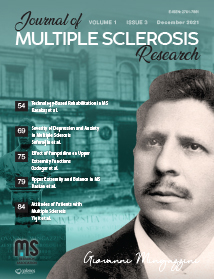Volume: 1 Issue: 3 - 2021
| 1. | Cover Pages I - X |
| REVIEW ARTICLE | |
| 2. | Technology-Based Rehabilitation in People with Multiple Sclerosis: A Narrative Review Hilal Karakas, Barbara Seebacher, Turhan Kahraman doi: 10.4274/jmsr.galenos.2021.2021-10-3 Pages 54 - 68 With the overall progress of technology, developing technological approaches has become an integral part of modern society, and using advanced technology in rehabilitation has gained increasing importance. This narrative review discusses the role of technology-based rehabilitation in people with multiple sclerosis by presenting the evidence, advantages, and disadvantages of robotic rehabilitation, virtual reality training applications, telerehabilitation, and movement analysis systems. Technological systems used in rehabilitation are based on motor learning principles by providing task-specific and highly repetitive activities. Current scientific evidence emphasizes that significant gains in ambulation and upper extremity function can be achieved with technological approaches. The use of technological approaches in multiple sclerosis rehabilitation, despite being challenging in terms of cost and accessibility, is promising and has enormous potential for the future. However, although the evidence supports the use of technological systems in multiple sclerosis rehabilitation, well-designed studies with a larger sample size are needed. |
| RESEARCH ARTICLES | |
| 3. | Factors Associated with Depression and Anxiety Severity in Multiple Sclerosis Patients Meral Seferoglu, Nizameddin Koca, Ali Ozhan Sivaci, Sukran Yurtogullari doi: 10.4274/jmsr.galenos.2022.2021-10-2 Pages 69 - 74 INTRODUCTION: The most common psychiatric comorbidities with multiple sclerosis are depression and anxiety. The Beck Depression Inventory (BDI) and Hamilton Anxiety Scale (HAM-A) are validated tests that are easy to administer and interpret, and are widely used to determine depression and anxiety, respectively. The aim of our study is to examine the association of depression and anxiety levels via the BDI and HAM-A with disease duration, disability, and treatments in patients with Multiple sclerosis (MS). METHODS: One hundred sixty-three MS patients who gave consent were included in the study. The BDI for depression and HAM-A scales for anxiety were applied. MS patients were analyzed in two subgroups: Relapsing-Remitting and progressive groups. Disability was evaluated with the Expanded Disability Status Scale (EDSS). RESULTS: A total of 163 patients, including 116 women and 47 men, had a mean age of 38.50±9.63 years, and the mean duration of MS diagnosis was 7.49±6.18 years. The rate of anxiety was 82.2% and depression was 33.7% according to HAM-A and BDI scale, respectively. In subgroup analysis, it was observed that anxiety and depression scores of RRMS patients were significantly lower than progressive subtypes. Anxiety and depression scores of patients with EDSS ≤3 were found to be significantly lower than those with EDSS >3. We found that disease modifying treatments did not have a significant effect on anxiety and depression scores. DISCUSSION AND CONCLUSION: In our study, it was observed that depression and anxiety were closely related to MS type and disability. The appropriate treatment of accompanying depression and anxiety is crucial for the management of the MS disease process. |
| 4. | The Efficacy of Fampridine on Upper Extremity Functions in Individuals with Multiple Sclerosis: Is There a Difference between Cerebellar and Pyramidal Dysfunction? Asiye Tuba Ozdogar, Sinem Ozcelik, Seda Dastan doi: 10.4274/jmsr.galenos.2022.2021-12-1 Pages 75 - 78 INTRODUCTION: Similar to its positive effect on the lower extremities, fampridine can also affect upper extremity dysfunction. This study evaluated the potential effect of fampridine therapy on upper extremity functions in patients with multiple sclerosis (pwMS) by comparing these on the basis of cerebellar and pyramidal dysfunctions. METHODS: Patients aged between 18 and 60 years with a diagnosis of multiple sclerosis and eligible for fampridine therapy due to walking difficulties were followed-up. Of these, patients with problems such as lack of coordination in hand functions or deficiencies in fine motor skills, dressing, writing, and/or buttoning were invited to take part in the study. Upper extremity functions were evaluated using the 9-Hole Peg Test (9-HPT), and general disability was evaluated with the Expanded Disability Status Scale. RESULTS: One hundred fifty-nine patients were followed-up for 12 months, and 151of them were included in the analysis. Seventy-seven (50 women) healthy controls (HCs) were also included. There was no statistically significant difference between the demographic characteristics of the two groups. A 19.8% improvement was observed in 9-HPT scores after one month of treatment (p=0.004). This improvement was observed to persist at the 24th month. Patients with a cerebellar FS score of 0 to 2 (n=76) improved significantly more (p<0.001) than those (23.5%) with a cerebellar FS score of 3 or higher (9.2%). DISCUSSION AND CONCLUSION: The results of this study show that fampridine improves upper extremity functions in pwMS. This improvement was more pronounced in the group with cerebellar dysfunction. |
| 5. | Investigating the Relationship Between Balance and Upper Extremity Function in People with Multiple Sclerosis Seda Dastan, Nurbanu Aygunduz Yapici, Asiye Tuba Ozdogar doi: 10.4274/jmsr.galenos.2022.2022-1-1 Pages 79 - 83 INTRODUCTION: Upper extremity dysfunction and balance problem are two important symptoms that are common in individuals with multiple sclerosis and reduce their quality of life. However, there is limited evidence of a direct relationship between these two symptoms. Therefore, this study aims to reveal the relationship between balance and upper extremity function, which is essential for pwMS. METHODS: Nine hundred and sixty-six patients were included [681 (70.5%) female, 285 (29.5%) male]. The Nine-Hole Peg Test (9HPT) was applied to evaluate upper extremity function. With the Activity-Specific Balance Confidence (ABC) Scale patients evaluated their confidence in their balance during activities and balance was tested with the The Timed Up and Go (TUG) test. RESULTS: There was a significant moderate positive correlation between the 9HPT and TUG (rho=0.566) and a moderate negative correlation with ABC score (rho=-0.464) in total participants. However, while there was a significant moderate negative correlation between 9HPT and ABC score in relapsing form, there was no relationship between 9HPT and TUG in pwMS with progressive form. DISCUSSION AND CONCLUSION: There is a significant relationship between upper extremity function and balance. In addition, the trunk, upper and lower extremities should be considered as a whole, since distal stabilization cannot be achieved without poximal stabilization. Consideration should be given to the upper extremity within the scope of balance assessments. |
| 6. | Attitudes of Patients with Multiple Sclerosis Towards Disease and Physical Activity Behaviors During the COVID-19 Pandemic Pinar Yigit, Ergi Kaya, Zuhal Abasiyanik, Ozge Sagici doi: 10.4274/jmsr.galenos.2022.2022-1-2 Pages 84 - 89 INTRODUCTION: This study aimed to investigate the considerations of patients with multiple sclerosis (pwMS) related to their disease and treatment, the frequency of going out, treatment and routine examination interruptions, and physical exercise habits during the pandemic. METHODS: Seven hundred forty-four pwMS (mean age: 41.44 years, 29.2% male, 70.8% female), who were followed in MS Outpatient Clinic in Dokuz Eylul University Hospital, Izmir, Turkey, were recruited. A structured survey was created and administered via phone to assess attitudes towards disease, the frequency of going out, treatment and routine examination interruptions, and physical exercise behavior. Additionally, demographic and clinical characteristics, their health status, and coronavirus disease 2019 (COVID-19) symptoms were also asked. RESULTS: 66.5% (n=495) of responders stated that their thoughts about the disease did not change during the pandemic. 94% (n=699) of the pwMS reported that they did not experience any disruption in their treatment. 59.9% (n=446) of the pwMS indicated no disruption in their routine controls. 25% of responders reported less physical activity, 17.1% reported more physical activity, 16.5% continued physical activity as usual. 41.4% reported that they did not perform any physical activity in the past and did not do so during the pandemic. DISCUSSION AND CONCLUSION: This large cross-sectional study has shown that the attitudes of the majority of pwMS towards their disease have not changed. The continuation of the follow-up of the patients during the COVID-19 period with telehealth applications may ensure the maintenance of treatment adherence and patients attitudes about the disease. |
| INDEX | |
| 7. | Referee Index Page E1 Abstract | |
| 8. | Author Index Page E2 Abstract | |
| 9. | Subject Index Page E3 Abstract | |














 Copyright © 2024 | Journal of Multiple Sclerosis Research
Copyright © 2024 | Journal of Multiple Sclerosis Research